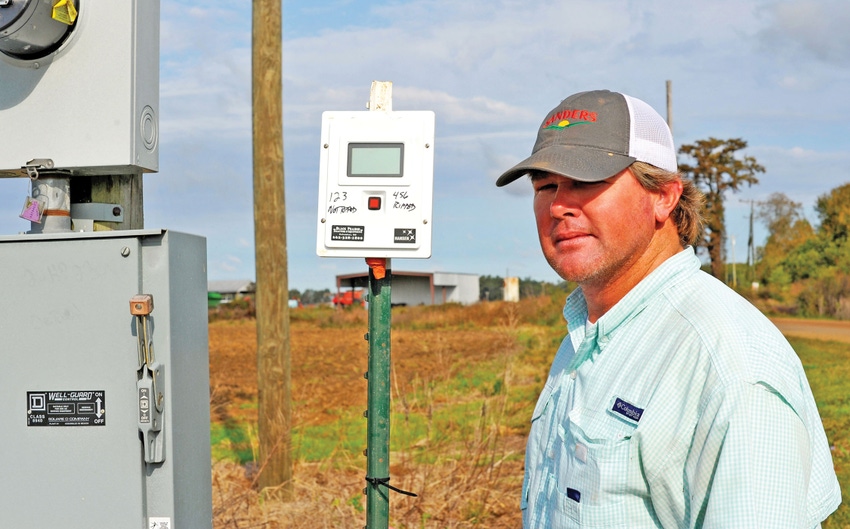December 3, 2014

For one accustomed to initiating irrigation every seven days like clockwork, relying instead on moisture sensors to trigger watering requires a good bit of adjustment. Making that change, however, has saved Mississippi corn and soybean grower De Paul both time and money.
Irrigating by the calendar date instead of by the plants’ moisture needs “created a lot of extra work for nothing, and I didn’t get paid back for those extra irrigation expenses. I wish I knew 15 years ago what I know now,” says Paul, who farms with his father, Denny Paul in Yazoo County, Miss.
Relying on advice from Dan Prevost, watershed specialist for Delta F.A.R.M. (Farmers Advocating Resource Management) and information from the Mississippi State University RISER Program led by Jason Krutz, the Yazoo City, Miss., producer installed moisture sensors on several of his fields in 2014.
To test the veracity of a moisture sensor-dictated irrigation system, Paul split a 90-acre Group V soybean field in half, managing one-half of the field with moisture sensors and the other half using his usual irrigation practices of watering every seven days, which is usually five to six irrigations per season. The 45 acres outfitted with moisture sensors were not watered unless directed to do so by the plants’ needs as directed by the computer-operated moisture sensors.
On the half of the field with moisture sensors installed, Paul did not irrigate in 2014. “What was going to be irrigated soybeans, essentially became dryland beans because we received timely rainfall through the season, and the moisture sensors never indicated the need to irrigate,” he says.The yield difference between the field’s two halves was about 3 bushels per acre. “The money I spent irrigating, I made back, but I didn’t make any additional profit off of the traditionally irrigated soybeans.”
Paul had a similar experience after installing moisture sensors in his corn fields this year. Traditionally, he waters irrigated corn every seven days, but he learned with moisture sensors that he could go 10 days or more between irrigation applications. Stretching out the days between irrigation initiations eliminates one to two waterings during the critical part of the growing season, he says.
“It was eye-opening to say the least, and I will implement moisture sensors a lot more across our farm in 2015,” Paul says.
Another lesson learned in 2014 was that with more efficient irrigation practices comes the need to improve soil compaction so that the water better penetrates into the soil.
“When we put moisture sensors in our fields this year, we noticed we had a compaction issue because the water didn’t appear to be soaking down into the soil after big rains,” Paul says. As a result of this anecdotal evidence, Paul and Prevost performed additional soil tests and discovered that 6 to 8 inches down in Paul’s silt loam soil, the dirt was highly compacted, with pressure measuring 1,000 pounds of force per square inch.
To help combat his soil compaction issues, Paul is planting a cover crop this winter in attempt to break through that hardpan. He’s using a Rowgator to plant a cover crop mix of tillage radishes, crimson clover and triticale- called the Charlotte Mix.
It’s not the first time Paul has taken Prevost’s advice in his quest to implement additional conservation practices on his farm. In 2008, Paul was one of several stakeholders who joined forces with Delta F.A.R.M. to improve the water quality of the Wolf Lake watershed.
According to Stoneville, Miss.-based Delta F.A.R.M., the Wolf Lake Project brought together stakeholders in the watershed to address water quality and to create a watershed plan to address sediment-nutrient run-off. The group worked with the Mississippi Department of Environmental Quality to secure funding, as well as to leverage both NRCS funding and private investment. When the project was completed, producers had installed several hundred pipes and several low-grade weirs, greatly improving water quality in the Mississippi watershed.
“The water quality of Wolf Lake is much better, we’ve reduced erosion on our fields, and drainage has drastically improved,” says Paul. “Delta F.A.R.M. has provided us with a lot of technical assistance. They are giving us a heads up about what’s coming in the future to help with water and soil conservation on our farm.”
You May Also Like




